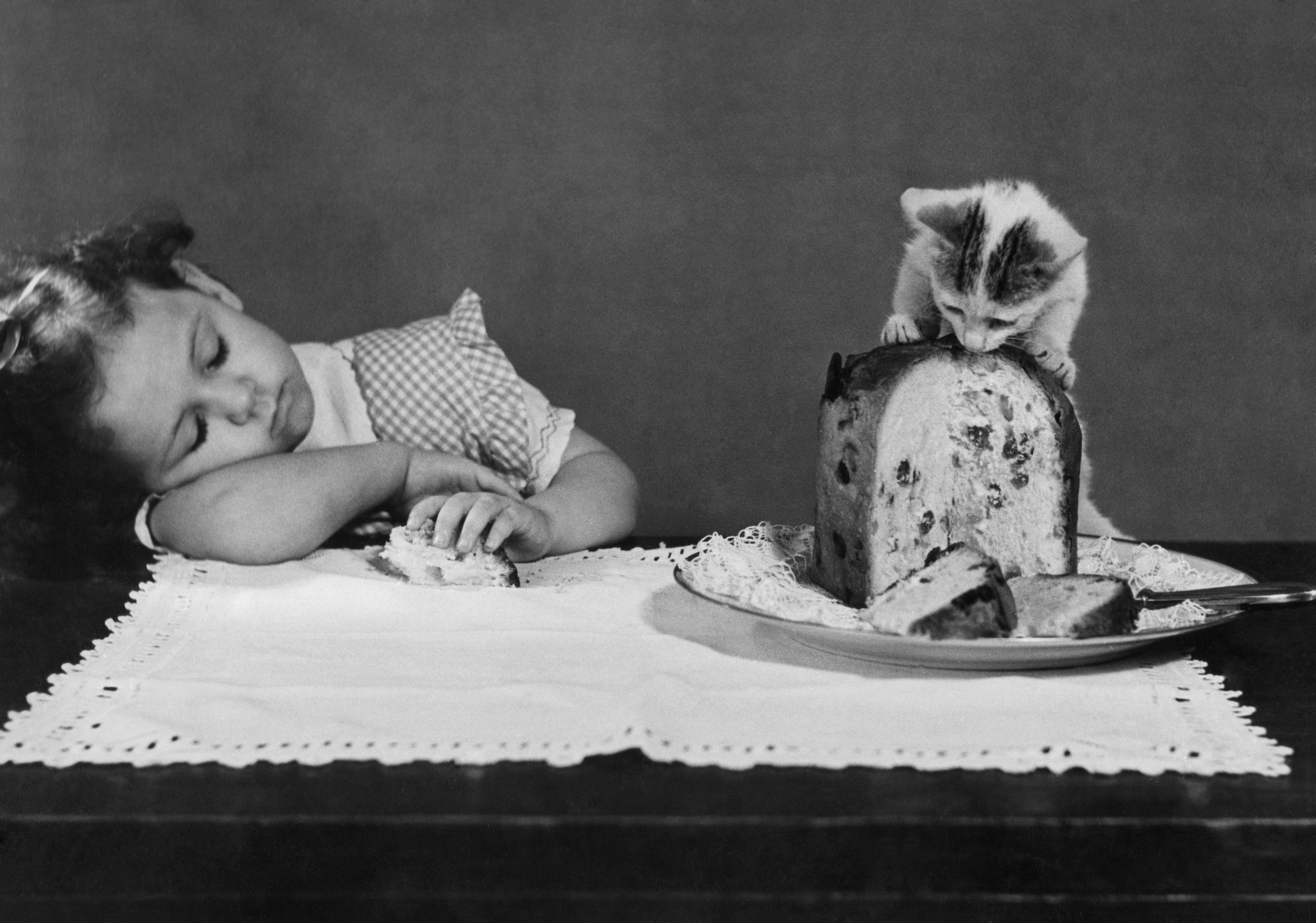Chris and I felt that our triumphant baking series needed a beautiful conclusion, as we refused to compete in the finale of the Great British Bake Off, which both had a gross technical challenge and published no recipe online. Because it is the holiday season, we decided to make something festive. Really, we wanted to make something that was a real dessert that we would be happy to have and not some stupid torture device invented by Paul Hollywood and Prue Leith.
We tossed around the idea of decadent apple pies, of making four types of cookies in a limited time frame, of mousse cakes and breads, and dozens of other ideas. Mostly, we were listing desserts we would like to eat, and making very little progress toward a conclusive choice.
That is, until Chris set his sights on panettone.
Panettone is an Italian sweet bread and fruitcake. Usually, when you buy it at the store, it is very dry and very boring. But when it is good, it is light and fluffy and luxurious and very, very festive. Chris brought up panettone as an option for us, and I tried—I really did—to shut him down. But I made a fatal error. I told him about how my friend Dayna Evans (a professional baker) has been on an infinite quest to make panettone. I know this because I have begged her to tell me about her many panettone trials and tribulations. I had heard the horror stories of dough that didn’t rise, of the dozens and dozens of eggs gone to waste. If she couldn’t do it, I tried to relay, we Defector Idiots were a lost cause.
Chris, though, was thrilled to hear about Dayna doing this because it was Dayna's recipe for sourdough starter that inspired him to bake during the pandemic. He said, “Oh man, this seems significant to me, that she is struggling with panettone just when I am searching for a fulfilling baking challenge.” Great, I thought. He’s been dissuaded. But he had not. Quite the opposite. Immediately afterward he typed, “I think I’m gonna try it.”
As she is a professional baker and a panettone expert, and we are very, very dumb, we asked Dayna to spiritually guide us through the process, and now she is here to blog with us! Dayna Evans is an excellent writer about food and other topics. She is also a newly full-time baker as the founder of Downtime Bakery in Philadelphia. Dayna tried to dissuade us, but we are stubborn.
Kelsey McKinney: I would like to begin by asking Dayna what she thought when we asked her to participate in this ordeal, which we sprung on her with very little warning.
Dayna Evans: Oh, well, I was pretty much like, “No.” I think maybe at first I kindly said to Kelsey, “Sounds fun! Lemme know!” but in my heart I was saying NO, don’t do it. Here’s the thing, though: Once you get thinking about panettone, you can’t stop. I could sense from Chris’s texts that he was determined so I let it happen. Glad that it did.
Chris Thompson: I know this sounds insane but it really was like the clouds parted and a light shone down when Kelsey said that you’d been wrestling with panettone. It’d been several weeks of us sort of half-heartedly suggesting ideas to each other, and all of them felt very arbitrary. I don’t know why knowledge of a third party working on panettone should be received as like A Sign From God, but there it is.
KM: I really, truly, did not want to make the panettone. But then by nature of saying it seemed too hard, and watching Chris immediately devote his entire life to the cause of creating it, I shifted. I guess, we need to like… uh… explain why panettone is a difficult bake, since no one has the show to guide them?
CT: Yeah, that is what I would like to understand as well. I have made panettone once now, and I was very surprised by how not-terribly this project went. Is it hard? Really?
DE: Can I start by saying something extremely rude?
KM: Please!
DE: Most google-able panettone recipes aren’t actually for the real thing. (Or rather, omit a good deal of stuff you’d wanna know to get it right.)
KM: Oh, shit!
DE: Like, perfect example: Martha Stewart posted this Instagram being like, Wow, I nailed panettone! Che bella! but to a person who has been obsessively thinking about this for way too long, I looked at her panettone and I was like, Martha, fail. Her panettone recipe you can finish all in one day, and that just isn’t panettone. Panettone is hard because it should take some time to build up a starter, then the dough itself should go for at least 24 hours, then all the mixing and adding of eggs and butter, it’s … a labor.
CT: Hmm, seems like my panettone is being called out for fraudulence right now. Not sure how I feel about this!
KM: Fraud!!!!!!! I, however, am not a fraud. No fraud! This bake is the first time in my life that I have googled “Kitchenaid mixer hot safe?” which seems to really say something.
DE: NO fraud. I think it’s kinda like … junior varsity and varsity, if that makes sense. Though in Italy, I think technically your dough should be naturally leavened for people to take it seriously?
CT: So just to clarify for our deeply confused readership: What we are talking about right now is the slow and delicate process of building a sourdough starter from organic flour and water and nurturing it until it is a yeasty beast and then using it to make a really rich and delightful dough, versus just, uhh, using instant yeast and having the whole thing done in 12 or 13 hours of minimal work.
KM: Yeah, just to clarify: The difference here is that Chris is the star of the JV team, and has a bright and promising future. Whereas I dropped a pass in the end-zone at the varsity level and am now the shame of the whole town.
DE: In fairness to everyone here, I’m basically the legacy player who hasn’t ever had a good season.
KM: Dayna, I already know about this because I have asked you so many prying questions about your journey with panettone, but perhaps you could tell the readers a bit about your playing history? Tell us first why you began your war with panettone.
DE: I love to eat panettone and I love to bake so I was like, Hey maybe I should just cut out the middle man and start making it myself. I think I made my first panettone four or five years ago when I knew next to nothing about the whole process, and in a way that kind of served me well. I was just proud that I had something that tasted like panettone. I’ve tried once every couple of years and it’s almost like, as my expertise in baking grows, my frustration with panettone grows alongside it. I got the closest I’ve gotten this year—with a naturally leavened dough made from a starter I trained for days—but it didn’t get the rise I want. So I gave up.
CT: Dayna, would you say that the challenge with getting the dough to rise is due to all the fruit? Or is it the other enriching of the dough? Or both?
DE: It’s a stressful mix of everything, unfortunately. If your starter isn’t quite active or strong enough in advance of making your dough, it won’t be able to support the insane volume of eggs, butter, sugar, and fruit you’re trying to stuff into the dough.
KM: You bake a lot, so maybe this is a dumb question, but do you feed your sourdough starter every single day? Is that how you keep it strong and brave?
DE: My bread starter, no—I feed that once a week and then once or twice before I do my big bakes on the weekends for the bakery. But my panettone starter—an entirely different starter—I was feeding every 12 hours for a week, then every three hours on the day I was set to make dough. EVERY THREE HOURS.
CT: Every 12 hours!! And then every THREE HOURS?!?!?! My God.
KM: Oh my god. Your dough was SO HUNGRY. So you went through like a regular bag of flour just feeding the panettone starter?
DE: It’s so stupid. Yes!
CT: Wow. Kelsey, you had a dormant starter just chilling in your fridge, yeah? That’s why you went with the Real Deal panettone recipe.
KM: Yeah, I was very into baking sourdough in like 2018 because my friend Leah was extremely good at baking sourdough and (more importantly) at making sourdough bread with cheese and bacon in it, which I loved. But then Leah moved away for a few years so my addiction was fucked up, so I began to make it myself! My starter is still the one I built off of hers, but very sadly she died last fall and I lost my will to make sourdough so the starter has just been chillin in my fridge. In anticipation of the panettone, I revived it, which was not very hard. I only fed it every day for three days and then twice a day for two days, so perhaps that is why it was not strong enough in the end. Next year, I will begin feeding it in November.
CT: I also did sourdough for a while at the start of the pandemic (along with approximately 900 million other people), but I let my starter die sometime in early 2021. So for this challenge I was stuck going Moron Mode, with a King Arthur overnight panettone recipe that uses instant yeast.
KM: I cannot explain to you how much I wish I had gone Moron Mode. At every phase of my bake, I thought I was about to conquer panettone, and become the best baker to ever live. The unearned confidence of this entire series was alive and well within me for NO REASON.
DE: Moron Mode RULES. I almost considered joining you in making your King Arthur panettone, Chris. But I miraculously had run out of eggs. One-hundred forty-four eggs.
KM: This is a great transition to talk about the ingredients required for this dough. There are so many.
Ingredients and Shopping
CT: The only weird or troublesome ingredients in King Arthur’s recipe were Fior di Sicilia and dried pineapple. Fior di Sicilia is something you have to order online, although for the recipe you are allowed to substitute orange oil, which I would also have had to order online. And dried pineapple is something that I simply refuse to use in a wintertime bake that originates in damn Italy.
KM: And candied orange! I managed to find Fior di Sicilia at the Italian market, but then my recipe didn’t even require it so I felt duped. The dried pineapple, I did find, but I had to make the candied oranges myself and then I made enough that I didn’t need the dried pineapples which were ALSO not in my recipe, which Dayna sent me from GREAT ITALIAN CHEFS DOT COM! Prego!
CT: I skipped the pineapple and instead made some candied orange peel, which was nice because I was then able to package some up for a gift. Instead of Fior di Sicilia, I used a tiny drop of lemon essential oil, which I will admit freaked me out a lot.
DE: Very smart. Y’all are advanced!
KM: Dayna, whatever you do, do not read the other entries in this series.
DE: Haha listen, if you’re candying your own orange and swapping in different oils, then I’m calling you advanced.
CT: I also made my own, ah, panettone pan.
KM: Oh, right! Wow. I forgot we had so many trials in this bake because the bake took so damn long that I forgot them all. Chris, explain your pan, and then we will have Dayna tell us what the purpose of the panettone paper is anyway.
CT: So King Arthur says you can bake your panettone inside a 1.5-quart or two-quart straight-sided tall pan, if you don’t have the paper pan. It so happens that I have a tall two-quart straight-sided saucepan, perfect for the occasion. But! To me a panettone must have a paper wrapping, and it also must be stored so that it is hanging upside down, and so a panettone baked in a metal pan would simply not do.
DE: I’m not entirely sure where the origin of the paper case comes from, but it makes sense for baking them at scale—you can sell it right in the decorative paper. Plus, as Chris is saying, you have to hang panettone upside down once it's baked, so much easier to do if the thing you’re baking it in is light.
CT: Yeah! So what I did is I cut and folded and glued a paper shopping bag so that it was shaped to the interior of the saucepan. I then lined the interior of that paper pan with parchment paper, so that the bread would not soak into the liner, and finally I lined the exterior of the bottom of the paper pan with aluminum foil, just in case the paper was not strong enough for the job. Behold!
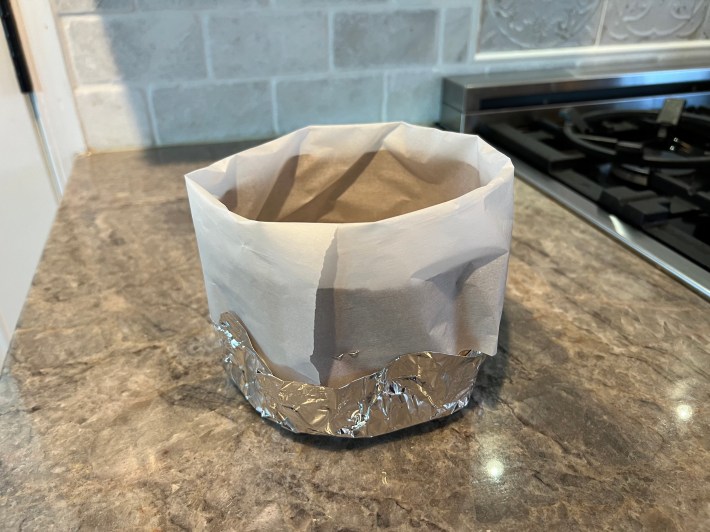
KM: I think you were very innovative with the paper, Chris! My adventure with the paper was an accident. I meant to make my paper like Chris, but in the heat of this adventure, I realized that my bread hook was missing! (I still have not found it). So I went to the kitchen supply store in the Italian market to try and buy a new bread hook. They did not have a bread hook, but there was a very short Italian grandma there buying a whole stack of panettone papers, so I bought those instead.
DE: Next time, Kelsey, hit me up—I have a lot of panettone papers.
KM: I have just remembered that I could find neither white almond flour nor hazelnut flour for my icing, but assumed I could just blend up those nuts to make them. And I could not find pearl sugar for garnish, but decided I didn’t need it. Another bake, another shopping list mistake by me.
CT: My recipe did not call for icing, but I went ahead and got icing stuff because I liked the look of the panettone photos in the Real Italian Chefs recipe. Very festive! I then ran out of steam and did not wind up making any icing.
KM: How dare you. They are GREAT Italian Chefs.
CT: Merely Adequate Italian Chefs.
KM: Dayna, when you mentioned the 144 eggs earlier, how many panettones is that for? And do you have to buy the eggs in bulk. Eggs are so expensive.
DE: Yes, so there’s a restaurant supply store near my house where I bought 12 dozen eggs when I started working on the recipe again in October. Different recipes call for different quantities of eggs but I went through those eggs so fast. But, the saddest part is that most recipes use only the yolks, so I was swimming in egg whites for weeks, trying to figure out what to do with them.
KM: I literally have an entire tupperware of egg whites in my fridge, lonely and with no future, after making this once, so I cannot imagine how many you had
DE: Make financiers! Or meringues! Pavlova! Or eat a lot of egg white omelets, which is what I did, begrudgingly.
Stage One: Feeding The Beast
CT: Here is where the recipes head off in different directions. The moron recipe is straightforward as hell: Mix together flour, instant yeast, and cool water, set the blob someplace safe, and give it 12 hours to, uhh, make science.
KM: Hahaha! I am filled with regret. It weighs down my body. I will die from it. My recipe required me to do things every three hours for 12 hours, mainly feeding my starter to turn it into a mommy dough. Do I know what a mommy dough is? No. Did I also start this process at noon, leading me to be forced to mix things at midnight? Yes! Every day, I choose hell. Dayna, please: Why did I have to do this mommy dough? What does it do?
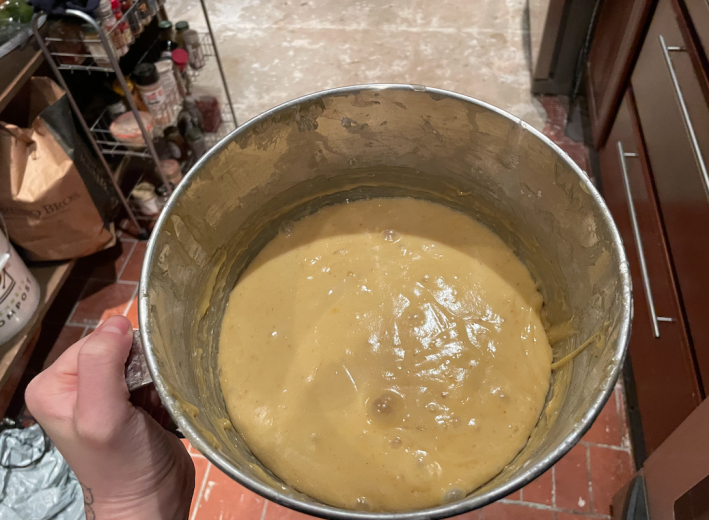
DE: Oh yeah, it’s basically just your designated panettone starter. Have you ever seen how they’re traditionally wrapped and kept in cloth? It looks very sexy. The living yeast in the mommy dough is what makes your panettone rise.
KM: Wow, that is very sexy! Looking at this also leads me to believe that I was never on the right track as my mother was always very sticky. It was never sexy.
DE: I struggled with the same thing! Still have no idea why mine was sticky. I’m still learning!
KM: So for Chris, the starter was the instant yeast. That was his mother dough. Chris what kind of science did it do?
CT: I’m checking the recipe now and actually there’s no indication of what it’s supposed to do during those 12 hours. But at the end of 12 hours in my oven, warmed only by the oven light, it was sort of bubbly and porridge-looking. Gruel-ish.
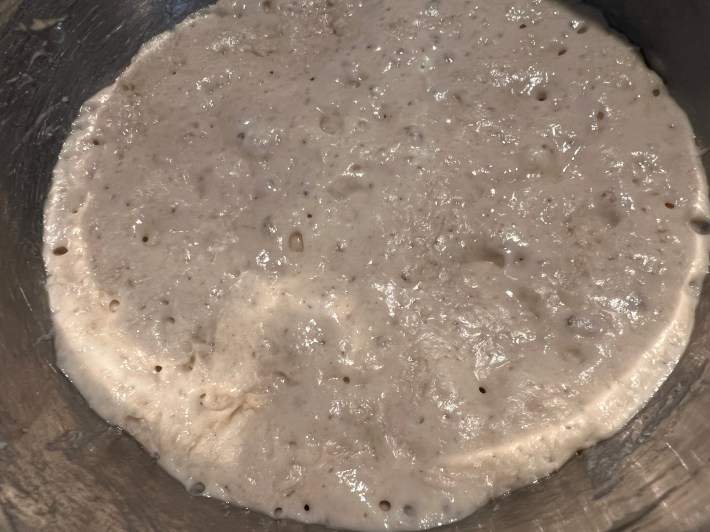
KM: That does not sound appetizing to be honest. Was yours also sticky?
CT: More, uh, slimy than sticky? But also sort of sticky. I realize I am not making this sound at all like something anyone would want to eventually eat. I understand that at this point you Great Italian Bakers had to do a lot of dividing and feeding? Or something?
KM: There were many dividings and feedings, yes. Essentially the 12 first hours were the same: we were all making the mother, which would rise the dough. The difference is that yours was hands-off, and the recipe by the Adequate Italians was extremely hands-on. The next step was making the first panettone dough. This is where I immediately became scared.
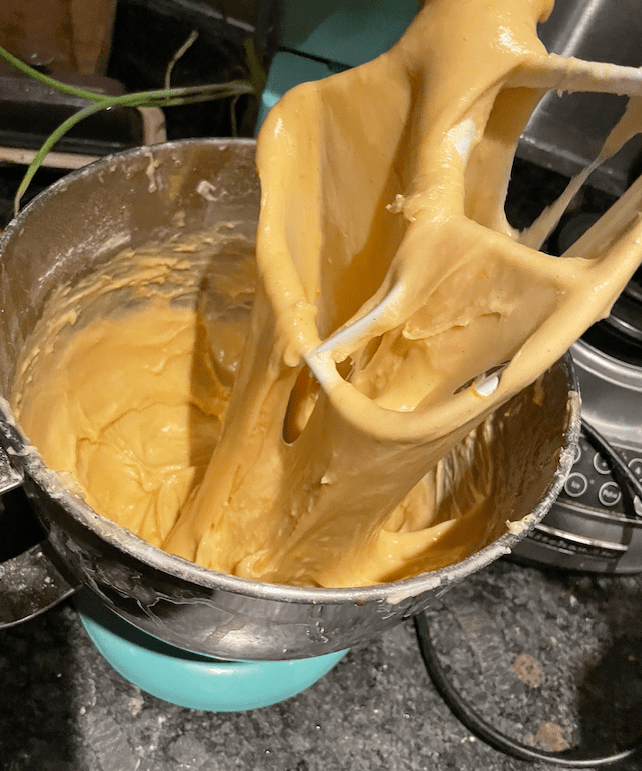
DE: What was scary about it, Kelsey?
KM: I had to add 200 grams of egg yolks to make the first dough. This took so many more eggs than I expected because I have no conception of weight. I thought it would be like three eggs. Instead, I think it was eight. This stressed me out, because I became afraid that in the end it would taste bad and I would have wasted all these eggs and time. Also, it was midnight, and I was sleepy and grumpy, which granted was my own fault.
DE: Never make panettone while grumpy or sleepy.
CT: Is it possible that the Swarthy Italian Chefs recipe includes more egg content (and all yolks, at that) than Prince Arthur’s because the natural yeast in the dough is supposed to be sturdier and more powerful? My recipe had just two whole eggs, and now I’m concerned that my panettone did not have enough eggy richness, or perhaps rich egginess.
DE: That’s an interesting shout, yeah. Panettone is just a really, really rich dough—lotta butter, too. But definitely the more technical recipes up the egg and butter content.
CT: It’s like panettone is really just an elaborate test of who can make the most overpowered yeast blob.
DE: Yes. Whoever is able to maintain a dough with that much egg yolk and have it rise above the paper is very, very skilled. There’s a reason that Roy Shvartzapel’s panettone is so airy and rich—his dough has a high quantity of yolks and butter and moisture.
KM: Oh my god I’m looking at this photo of his and it makes me want to die:
CT: Oh wow. That beats the shit out of my poor panettone.
Stage Two: Growing and Enriching The Dough
KM: When I woke up on Day Two of my Panettone Adventure, there were still 24 hours before I would be able to consume my panettone. This could have been discouraging, but luckily, sleeping had allowed my ego to return to full strength and I became convinced that I would dominate the panettone.
CT: What was the next stage like, for you? I truly have no concept of what this project was like for someone doing it the real way.
KM: I think after the mother was made, it was pretty similar, but I’m not sure.
DE: One of the tricky things about panettone that just takes practice is knowing how long to mix both doughs so they are nice and strong. Your mixer got super hot right, Kelsey?
KM: I truly, cannot explain how hot it got. I had to use a towel to touch it. Luckily, when I googled “kitchenaid mixer hot safe?”, I was reassured that the Kitchenaid would not explode.
CT: So one thing I do not understand is what is meant by “both doughs” in the context of panettone. The Duke of Arthur recipe only ever has one dough?
KM: Oh, so Dayna (I think) is referring to when you are adding shit. So in the Boys From Italy recipe, you make the mother, and then you mix the mother with eggs, water, sugar, flour and butter. You wait. And then you mix MORE of all that plus the candied oranges and raisins and stuff.
DE: Oh yeah, my bad. Usually there are two stages you’re working with.
CT: Ah OK. Yes, the moron recipe also had these stages. After making the “starter,” you add the non-fruit components of the dough—flour, water, eggs, butter, more yeast, and sugar—let it sit for a while to rise, and then add the fruit and zest. The recipe says to let it rise in this middle stage for 60 to 90 minutes, but mine did very little rising in that span of time.
This is the closest I came to freaking out, because for however many of these baking blogs the timer was GOD. It took me a long time to really accept that I was not subject to a timer, here. I simply let the dough sit in a warm place until it began to rise. This was a great feeling. It's amazing how much more durable my confidence was as I adapted to not having the timer breathing down my neck. And when the dough finally did start to rise it really exploded upward, growing by the minute.
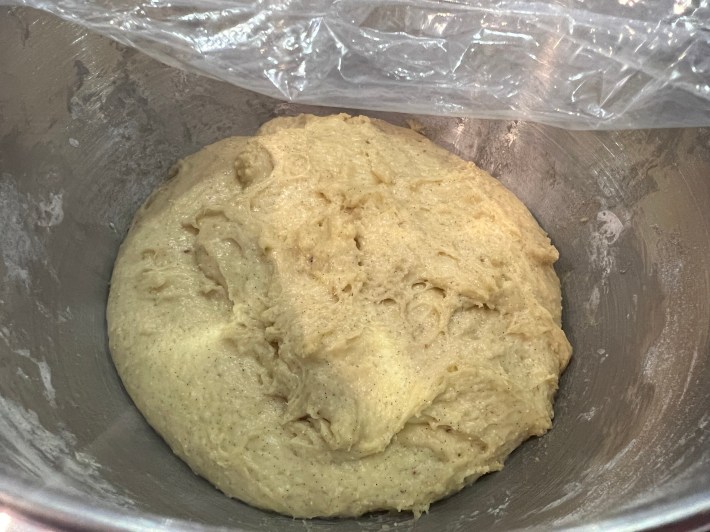
KM: May I admit something embarrassing to both of you?
DE: Yes!
CT: Certainly!
KM: I have absolutely zero ability to gauge how much anything has risen. I even take pictures sometimes to try and tell the difference between where I started and where things are now, but it’s like I have face-blindness for dough rising. The photos look the same to me, always. I cannot tell! So I’m just like … go with god, I guess!
CT: Oooh, that’s really interesting to me. I guess I look more for it to kind of soften and become poofy and blobbish rather than to grow any specific amount.
DE: Have you ever tried the painters tape trick?
KM: So, when I feed my starters, I put a rubber band around the container where the top of the starter is, so I can see for sure that it has grown. This works. And when I make bread inside a glass bowl, I mark the outside with painter’s tape. But inside the steel hell of the Kitchenaid mixing bowl, anything could have been happening! I would like us to talk about keeping the dough warm, too, since that was a problem we had!
CT: Yeah! This part was very fun, to me. I did my proving in my oven—well, the first stages—and I used the oven light to warm the space. But when that did not seem to be working for this stage, Dayna suggested the very cool idea of adding a bowl of warm water, which very quickly bumped up the temperature inside my oven by two or three degrees and did seem to accelerate the rise.
KM: Dayna, I also added the warm water bowl at some point but … how does that work?
DE: You’re basically introducing kind-of-steam into your oven, in a very janky way. So it adds some warmth if you keep the door closed. I shamefully admit that I’ve had a proofing box for many years at this point so I’m not as familiar with home tricks for warming doughs up as I used to be. But the warm bowl of water typically works to raise the temp a bit.
KM: It did work for me! I used it for the rise after I put the doughs into their papers too!
CT: I had to go in a slightly different direction for the third phase. I don’t know enough about baking, I guess, and I was worried that if I did my third proof—after adding fruit and zest and lemon oil to the dough—inside my oven, I would have to then let it sit and potentially cool on my countertop while preheating the oven for the bake, possibly causing it to fall?

KM: Oh god. I forgot entirely about that painful time where the oven was preheating. During this time I set my dough on top of very large heating pad and covered them with a towel. I then put all of this by the vent to the oven. Still, they were not really warm enough. But my microwave was very cold, which I later figured out is because my microwave vents outside??? A problem to be dealt with later.
CT: I know this is not strictly a Great British Bake Off challenge, but I could still hear Paul Hollywood’s voice in my head, muttering the word “overproved.” So instead of proving in the oven in the third stage, I put my dough (inside the DIY panettone pan) in the microwave, with a small flashlight, a mug of hot water, and a tea light, which I would light and allow to burn for a minute or two until the temperature rose to 85 degrees, and then blow out. In this way I was able to keep the temperature inside the microwave between 83 and 85 degrees pretty consistently, and it had the feel of a neat alchemical type of thing.

KM: Chris! Wow! You are an innovator and a scientist! I was going purely on heat vibe. Despite having an oven thermometer, I do not really trust it, so I was just kind of making it “warm.” Perhaps this is, ultimately, why I am a generally bad baker. I hate precision.
CT: Kelsey, I was also going off of heat vibes until Dayna mentioned that she likes to prove between 80 and 83 degrees, and it occurred to me that I have the equipment necessary to actually know the temperature inside the space. To me this was extremely comforting.
Dayna, can you explain what a proofing box is?
DE: Oh, sure! It’s a plastic box that regulates temperature through some sort of wizardry.
KM: Wait. Wait. Wait. It’s not a kitchen appliance? On Great British Bakeoff they are always opening a drawer that looks like an appliance.
DE: I think you can have it be part of your oven setup (some people even have a proofing setting on their oven)—but mine is a standalone appliance that I plug in.
CT: Oh wow, that’s much more fancy than I was picturing. When you said “plastic box” I was picturing like a plastic shipping crate, turned upside down on your countertop.
DE: The funny thing is, though, it really feels like that. It collapses into itself but really it’s just plastic walls that sit over a glorified hot plate.
CT: How long does the Serious Italian Fellows recipe suggest for this final proof? And at what point would a baker know to throw in the towel and accept that their panettone will not rise and become large and impressive?
KM: Chris, thank you so much for asking. It recommends “six hours” but then in the instructions there is a seven-hour gap between when it says to divide the dough and pre-heat the oven. I let my doughs rise for seven hours because it was most convenient for me, and then I gave up.
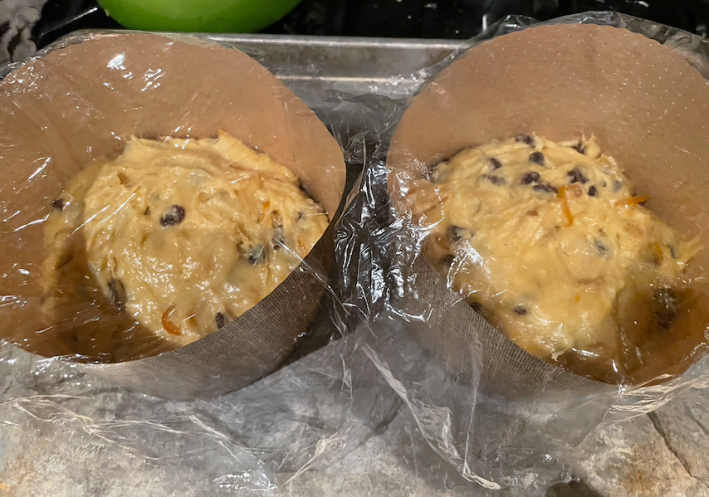
CT: Oh my God, seven hours?? Hahahaha!! My idiot recipe allowed “about one hour” for this third round of proving. I believe I had it in the candle-and-flashlight chamber for approximately 80 minutes, in the end. It rose beautifully. God bless instant yeast.
Stage Three: The Bake
KM: The baking was the easiest part of this whole thing! Just bake until the inner part of the panettone reaches 94 degrees celsius and voila. It was about that easy for me except the whole time I was sitting on the ground, pouting at my panettone for not rising enough. How did it go for you?
CT: Once again, heat management was an issue for me. It’s just impossible, I have found, to trust my oven to attain and maintain the indicated temperature.
My instructions said to do 10 minutes at 400 degrees, and then another 10 minutes at 375 degrees, and then 25 to 35 minutes at 350 degrees, at some point in there tenting aluminum foil over the top to prevent the crust from browning too much. I would say that the third stage of baking, at 350, lasted closer to 50 minutes, or possibly even an hour? It just took forever for my panettone to reach the desired 190 degrees in the middle.
KM: Dayna, is this why you bought the fancy oven? So the numbers on your oven would be correct?
DE: Oh god no. My fancy oven is somehow even more confusing than my regular oven. One thing I’ve learned about ovens though is that you get to know what their problems are and you adapt to that. Chris, your oven is confusing temp-wise?
CT: It’s so bad. It’s electric—I honestly do not know if that’s part of the problem, but it’s information—and it will often at random seem to just wildly overshoot the temperature on the dial. At other times it seems like it will just never come all the way up to temperature. It’s incredibly frustrating.
I don’t have a toaster here, but my child likes to eat toast. This is always an adventure with the broiler in my oven. Some mornings it takes 19 hours to brown one slice of sandwich bread. Some mornings the bread is instantly turned to charcoal the moment it is under the heating element. Super fun!
KM: This is why I will never be moving again. My last oven (whom I was married to for eight years) only had two modes: very hot and pretty hot, and I was very good at dealing with it. This new oven is my enemy. I miss my terrible gas oven that was always consistent.
CT: Dayna, before we get into the results of our bakes, I would like to ask what does normal failure look like at the end of a panettone project? What is the average would-be panettone baker finding when they cut open their panettone?
DE: I would say most often you’ll encounter a dense crumb. Everyone is familiar with the super airy, light, holy panettone texture—it comes apart like candy floss in your hands. But when your starter isn’t strong enough or you haven’t mixed your dough well enough and the strength just isn’t there, it can sink under the weight of all the ingredients. So you’ll cut it open and see more of a fruitcake or pound cake texture or consistency.
CT: I think when I was imagining my future panettone, I never expected total success, but I was imagining a kind of pane italiano texture? Like a light and chewy same-day bread, with fruit. How foolish and naive I was in those simpler times.
KM: Damn. I dream of that strength of bread, of the light airy texture, of giant holes between the layers of bread. Sadly. It was only a dream, for me.
CT: Yeah! Giant holes! That’s what I was hoping for. Some medium-to-giant holes in there. Kelsey, I assume you also went so far as to hang your panettone during the cooling phase? How did this go for you?
KM: I have rarely been as scared during a bake as when, after 48 hours of work, sweaty and miserable, I shoved kebab skewers through my breads and hung them upside down. If they hadn’t hung there, I would have a had a breakdown for sure. But they did! They hung very happily between two big boxes I found! Did yours hang? Why did we have to hang them anyway?
CT: My panettone did hang! I wound up jamming four skewers through it—two pre-bake, which eventually browned past the point of structural integrity, and then two post-bake—and then used two cereal boxes to prop it up inside my pantry. My kitchen smelled incredible.

KM: My kitchen also smelled so, so good. I was very happy. I told my partner that worst case it was a very high-labor incense. Dayna, why did we have to hang them? Do you know? Is it an old lore? Is it witchcraft?
DE: From how I understand it, it’s one additional way to get some loft out of your dough. So the times that I haven’t hung them, you see them sink slightly in the center and the result is denser and less aerated. I watched some YouTube video once that actually calculated you get something like an extra quarter-inch height on your panettone when you hang it. It’s stretching itself out a bit at the end.
KM: Wow! I believe that is worth it only because I did not drop my panettone. Had I dropped it, I would declare that step an atrocity.
DE: Once I hung mine upside down and it all just tumbled out of the paper. Horrible!
KM: Oh God. I would have burst into tears.
The Finished Product
KM: Well, Chris. How did your panettone turn out?
CT: Well. It certainly smelled great and had great flavor. And I felt great about it! But a few minutes ago, as I saw Dayna type out the words “more of a fruitcake or pound cake texture or consistency,” a cold chill ran up my spine. I knew that it was a little bit dense, but that is an exact description of its texture. It was pound cake with fruit in it. Really fragrant and delicious pound cake with fruit in it, but definitely a failed panettone.
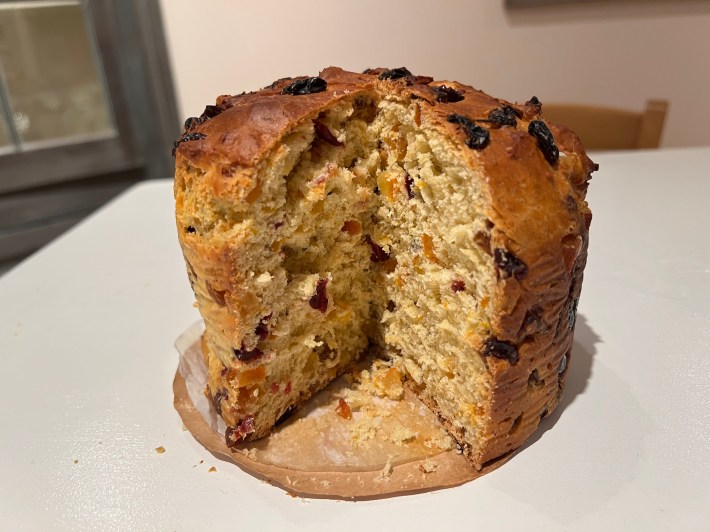
KM: Chris, I do not think you should say it is a failed panettone. Most panettones, I’m sure, are worse than yours. Take mine, for example! Mine also had the texture of a pound cake. It is so dense, I can barely eat a whole slice of it, and I am a very hungry girl.
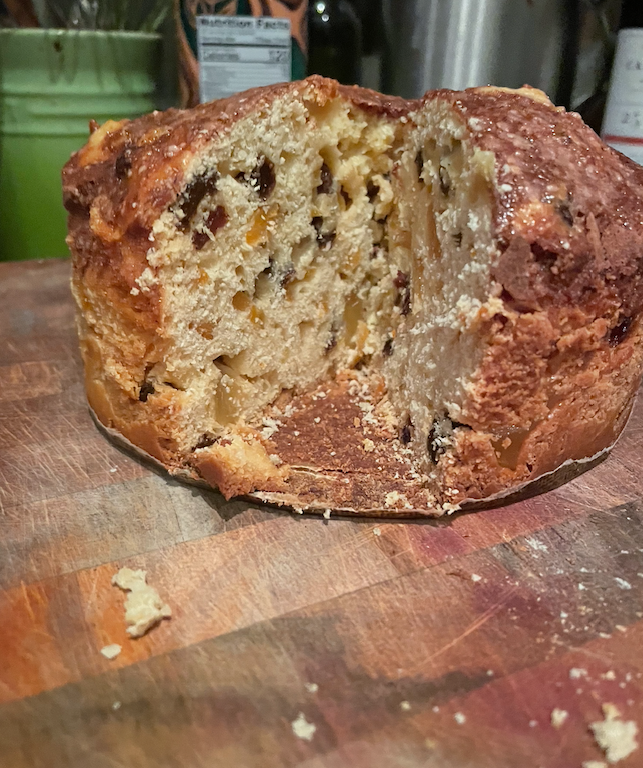
CT: [Henny Youngman voice] Take my panettone, please!
KM: Dayna, how do you think we did? Please weigh in on our panettones.
DE: Here is some wisdom that I’ve learned and will share. Making a technically accurate, stunningly gorgeous, and naturally leavened panettone is really, really fucking hard. It takes some bakers years to get it right even once, and even for the experts who have been doing it for years, there’s still a bit of mystery baked into the process. When my panettone wouldn’t turn out right, I’d be really disappointed—but now I realize that I just made something panettone-adjacent and that rules, too. My friend Ray had never had a panettone before and I sent them one of my tests. I remember they were like, Hey, this is good, whatever it is. And that’s how I’m gonna think about it. And how you guys should think about it. Maybe it wasn’t like, legendary Real Super Duper Italian Chefs panettone … but it’s good, whatever it is.
CT: Dayna, would you say that you have at least come close to making what you consider a perfect panettone?
DE: Lol no.
KM: Lmao. How close have you gotten?
CT: Hahaha!
DE: I think I’m like ……………. 65 percent there. Maybe.
KM: The worst part of this whole bake, to me, was that when I cut into my dense poundettone cake, I knew immediately in my soul why Dayna has become so committed to trying to get this right. I knew, instinctively, that I would be forced to do this again next year. Unlike every other GBBO bake we have done, this one I will be returning to. Did you feel the same, Chris?
CT: Kelsey, I ordered a bag of organic whole wheat flour yesterday so that I can restart a sourdough starter, so that I can try to make real-deal panettone quite literally next week.
KM: NEXT WEEK!?
CT: I’ve panettone brain!
DE: Best of luck, Chris.
KM: Thank you for joining us, Dayna! And cursing us with these panettone brains.
